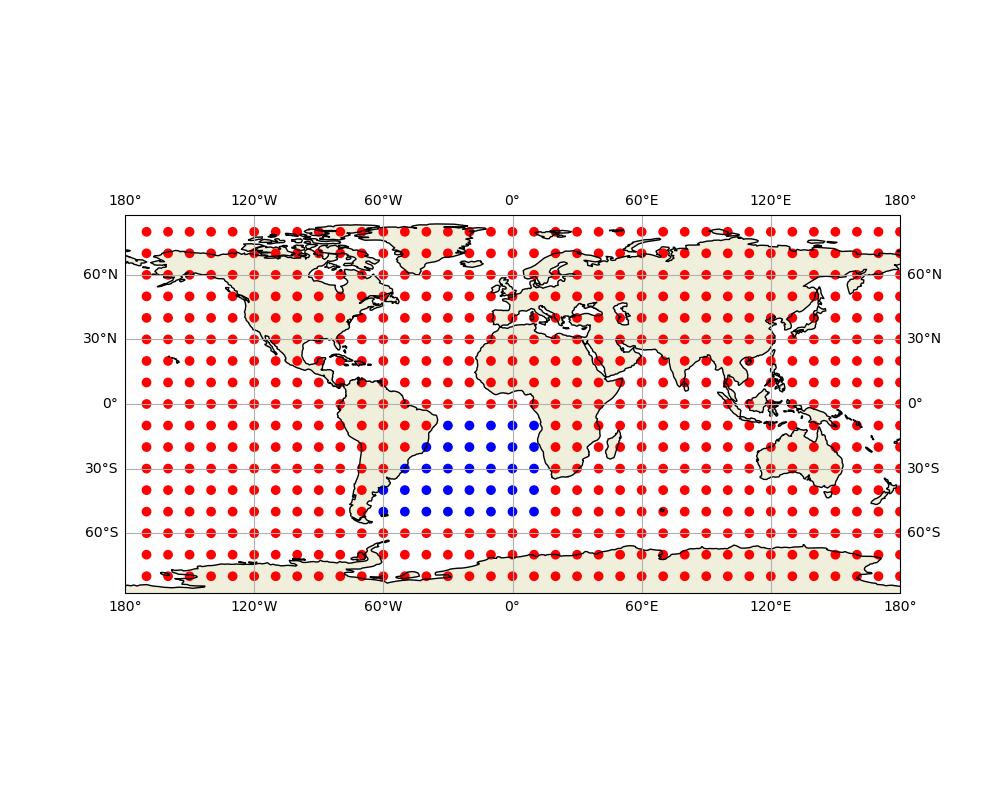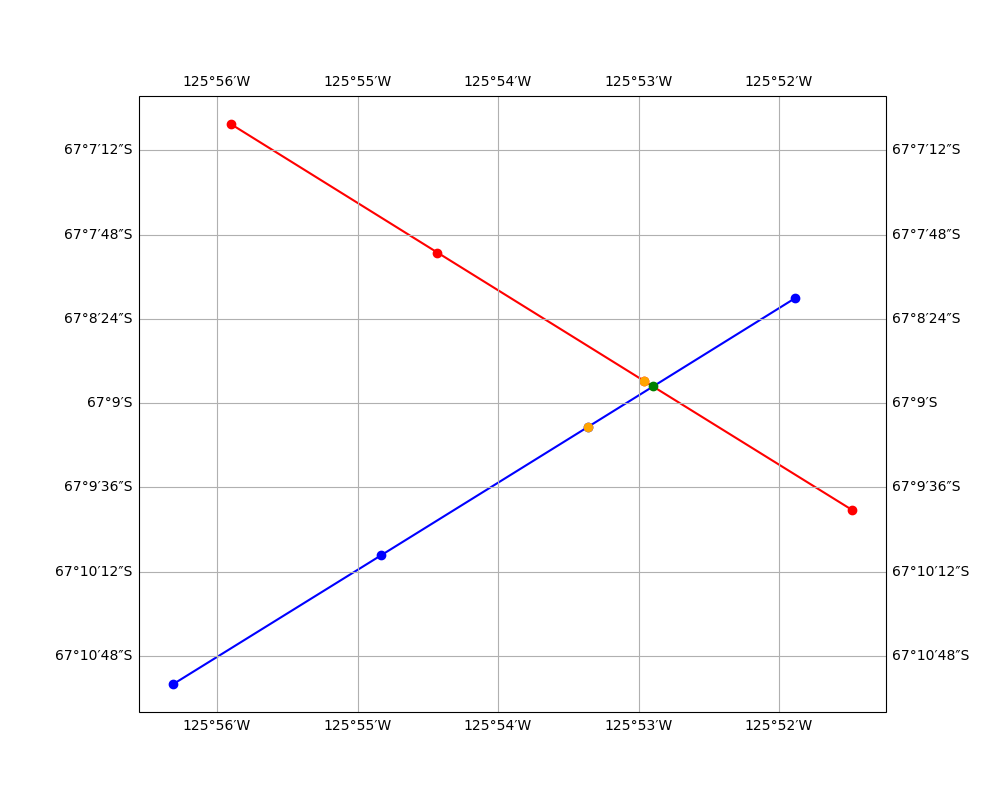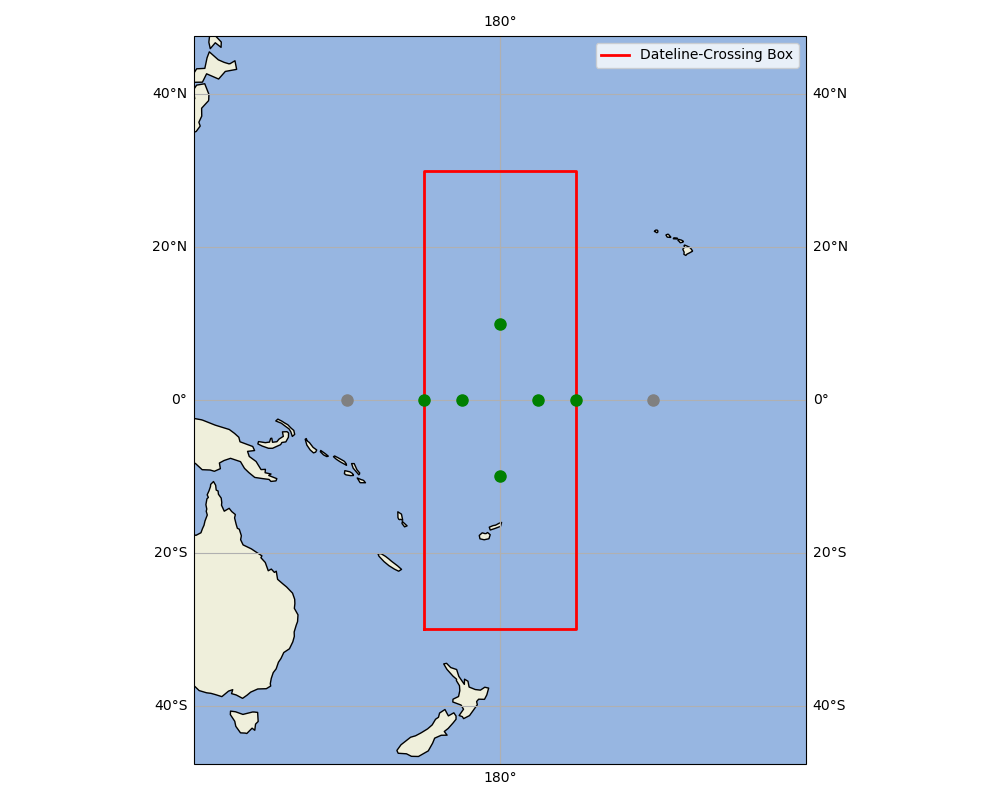Note
Go to the end to download the full example code. or to run this example in your browser via Binder
Geodetic Objects#
The library provides utilities to manage geodetic coordinates. While other
libraries offer more exhaustive geodetic functionalities, pyinterp includes
these objects because its C++ core requires geodetic information to be passed
from Python.
This example demonstrates how to use the primary geodetic objects available in
pyinterp:
pyinterp.geodetic.Spheroid: Defines the reference ellipsoid.pyinterp.geodetic.Coordinates: Handles coordinate system transformations.pyinterp.geodetic.Point: Represents a single geographic point.pyinterp.geodetic.Box: Represents a rectangular geographic area.pyinterp.geodetic.LineString: Represents a sequence of points.pyinterp.geodetic.Polygon: Represents a closed geographic shape.pyinterp.geodetic.Crossover: Calculates the intersection of two lines.
Let’s start by importing the necessary libraries.
import timeit
import cartopy.crs
import cartopy.feature
import matplotlib.pyplot
import numpy
import pyinterp.geodetic
World Geodetic System (WGS)#
The pyinterp.geodetic.Spheroid class describes the reference
ellipsoid used for calculations. By default, it represents the WGS84 system.
wgs84 = pyinterp.geodetic.Spheroid()
print(wgs84)
Spheroid(6378137.0, 0.0033528106647474805)
You can also define other ellipsoids, such as GRS80, by providing the semi-major axis and the inverse of flattening.
grs80 = pyinterp.geodetic.Spheroid((6378137, 1 / 298.257222101))
print(grs80)
Spheroid(6378137.0, 0.003352810681182319)
Coordinate System Transformations#
The pyinterp.geodetic.Coordinates class is used internally to
convert between geodetic latitude, longitude, and altitude (LLA) and
Earth-Centered, Earth-Fixed (ECEF) coordinates.
Here, we measure the performance of transforming a large number of points from the WGS84 to the GRS80 coordinate system.
generator = numpy.random.Generator(numpy.random.PCG64(0))
lon = generator.uniform(-180.0, 180.0, 1_000_000)
lat = generator.uniform(-90.0, 90.0, 1_000_000)
alt = generator.uniform(-10_000, 100_000, 1_000_000)
Create coordinate system handlers for WGS84 and GRS80
a = pyinterp.geodetic.Coordinates(wgs84)
b = pyinterp.geodetic.Coordinates(grs80)
Time the transformation
Transformation took: 0.085291 seconds
Geodetic Point#
A pyinterp.geodetic.Point represents a single location defined by
its longitude and latitude in degrees.
paris = pyinterp.geodetic.Point(2.3488, 48.8534)
new_york = pyinterp.geodetic.Point(-73.9385, 40.6643)
Points can be serialized to and from the Well-Known Text (WKT) format.
print(f'WKT representation of Paris: {paris.wkt()}')
print('Is the WKT representation of Paris equal to the original point? '
f'{pyinterp.geodetic.Point.read_wkt(paris.wkt()) == paris}')
WKT representation of Paris: POINT(2.3488 48.8534)
Is the WKT representation of Paris equal to the original point? True
Distance Calculations#
You can calculate the distance between two points using different geodesic algorithms: Andoyer, Thomas, or Vincenty. The distance is returned in meters.
Distance between Paris and New York (andoyer): 5851.416 km
Distance between Paris and New York (thomas): 5851.423 km
Distance between Paris and New York (vincenty): 5851.423 km
The library also provides a vectorized function,
pyinterp.geodetic.coordinate_distances(), for calculating distances
over large arrays of coordinates efficiently.
lon1 = numpy.arange(0, 10, 1, dtype=numpy.float64)
lat1 = numpy.arange(0, 10, 1, dtype=numpy.float64)
lon2 = lon1 + 1.0
lat2 = lat1 + 1.0
distances = pyinterp.geodetic.coordinate_distances(lon1,
lat1,
lon2,
lat2,
strategy='vincenty',
wgs=wgs84,
num_threads=1)
print('Vectorized distance calculations:')
for i in range(len(distances)):
print(f'Distance between ({lon1[i]:.1f}, {lat1[i]:.1f}) and '
f'({lon2[i]:.1f}, {lat2[i]:.1f}): {distances[i]:.3f} m')
Vectorized distance calculations:
Distance between (0.0, 0.0) and (1.0, 1.0): 156899.568 m
Distance between (1.0, 1.0) and (2.0, 2.0): 156876.149 m
Distance between (2.0, 2.0) and (3.0, 3.0): 156829.329 m
Distance between (3.0, 3.0) and (4.0, 4.0): 156759.142 m
Distance between (4.0, 4.0) and (5.0, 5.0): 156665.642 m
Distance between (5.0, 5.0) and (6.0, 6.0): 156548.897 m
Distance between (6.0, 6.0) and (7.0, 7.0): 156408.997 m
Distance between (7.0, 7.0) and (8.0, 8.0): 156246.045 m
Distance between (8.0, 8.0) and (9.0, 9.0): 156060.165 m
Distance between (9.0, 9.0) and (10.0, 10.0): 155851.498 m
Geodetic Box and Polygon#
A pyinterp.geodetic.Box defines a rectangular area from two corner
points.
box = pyinterp.geodetic.Box(new_york, paris)
print(f'Box WKT: {box.wkt()}')
Box WKT: POLYGON((-73.9385 40.6643,-73.9385 48.8534,2.3488 48.8534,2.3488 40.6643,-73.9385 40.6643))
A pyinterp.geodetic.Polygon is a more general shape defined by a
series of points. A box can be converted to a polygon.
polygon = pyinterp.geodetic.Polygon.read_wkt(box.wkt())
print(f'Polygon WKT: {polygon.wkt()}')
Polygon WKT: POLYGON((-73.9385 40.6643,-73.9385 48.8534,2.3488 48.8534,2.3488 40.6643,-73.9385 40.6643))
You can perform various geometric operations, such as calculating the area in square meters or getting the envelope (bounding box).
print(f'Area of the polygon: {polygon.area(wgs=wgs84) * 1e-6:.2f} km²')
simple_polygon = pyinterp.geodetic.Polygon.read_wkt(
'POLYGON((0 0, 0 7, 4 2, 2 0, 0 0))')
print(f'Envelope of a simple polygon: {simple_polygon.envelope()}')
Area of the polygon: 4967683.94 km²
Envelope of a simple polygon: ((0, 0), (4, 7))
Selecting Points within a Polygon#
Polygons are useful for selecting points that fall within a specific area. Here, we define a polygon for the Gulf of Mexico and check which points from a grid are inside it.
gulf_of_mexico = pyinterp.geodetic.Polygon.read_wkt(
'POLYGON ((-97.5 20, -97.5 30, -82.5 30, -82.5 20, -90 17.5, -97.5 20))')
Create a grid of points
lon = numpy.arange(-100, -80, 2, dtype=numpy.float64)
lat = numpy.arange(15, 35, 2, dtype=numpy.float64)
mx, my = numpy.meshgrid(lon, lat)
Use the covered_by method to get a mask of points inside the polygon.
Now, let’s visualize the polygon and the selected points.
fig = matplotlib.pyplot.figure(figsize=(10, 8))
ax = fig.add_subplot(111, projection=cartopy.crs.PlateCarree())
ax.add_feature(cartopy.feature.LAND)
ax.add_feature(cartopy.feature.OCEAN)
ax.add_feature(cartopy.feature.COASTLINE)
ax.gridlines(draw_labels=True, dms=True, x_inline=False, y_inline=False)
ax.set_extent([-100, -80, 15, 35])
# Plot the polygon boundary
poly_lon, poly_lat = zip(*((pt.lon, pt.lat) for pt in gulf_of_mexico.outer),
strict=False)
poly_lon = numpy.array(poly_lon)
poly_lat = numpy.array(poly_lat)
ax.plot(poly_lon, poly_lat, color='red', transform=cartopy.crs.Geodetic())
# Plot the points, coloring them based on whether they are inside the polygon
ax.scatter(mx[mask],
my[mask],
color='green',
label='Inside',
transform=cartopy.crs.PlateCarree())
ax.scatter(mx[~mask],
my[~mask],
color='gray',
label='Outside',
transform=cartopy.crs.PlateCarree())
ax.legend()

<matplotlib.legend.Legend object at 0x13bb98fb0>
Crossover Detection#
The pyinterp.geodetic.Crossover class is used to find the
intersection point between two line segments, which is particularly useful for
finding crossovers between satellite tracks.
We’ll define two simple line segments (half-orbits).
lon1 = numpy.array([234.068, 234.142], dtype=numpy.float64)
lat1 = numpy.array([-67.117, -67.163], dtype=numpy.float64)
lon2 = numpy.array([234.061, 234.135], dtype=numpy.float64)
lat2 = numpy.array([-67.183, -67.138], dtype=numpy.float64)
Create the Crossover object from two LineString objects.
Check if an intersection exists.
intersection_point = None
if crossover.exists():
print('A crossover exists between the two lines.')
# Search for the crossover point
intersection_point = crossover.search()
if intersection_point:
print(f'The intersection point is: {intersection_point}')
# Find the indices of the nearest points on each line to the
# intersection
nearest_indices = crossover.nearest(intersection_point)
if nearest_indices:
print('Nearest point on line #1: '
f'{crossover.half_orbit_1[nearest_indices[0]]}')
print('Nearest point on line #2: '
f'{crossover.half_orbit_2[nearest_indices[1]]}')
else:
print('No crossover found.')
A crossover exists between the two lines.
The intersection point is: (-125.882, -67.1482)
Nearest point on line #1: (234.142, -67.163)
Nearest point on line #2: (234.135, -67.138)
Finally, we visualize the two lines and their intersection point.
fig = matplotlib.pyplot.figure(figsize=(10, 8))
ax = fig.add_subplot(111, projection=cartopy.crs.PlateCarree())
ax.add_feature(cartopy.feature.LAND)
# Plot the lines
ax.plot(lon1,
lat1,
'-o',
color='red',
label='Line 1',
transform=cartopy.crs.Geodetic())
ax.plot(lon2,
lat2,
'-o',
color='blue',
label='Line 2',
transform=cartopy.crs.Geodetic())
ax.set_extent([
min(lon1.min(), lon2.min()) - 0.01,
max(lon1.max(), lon2.max()) + 0.01,
min(lat1.min(), lat2.min()) - 0.01,
max(lat1.max(), lat2.max()) + 0.01
])
# Plot the intersection point
if intersection_point:
ax.plot(intersection_point.lon,
intersection_point.lat,
'o',
color='green',
markersize=10,
label='Intersection')
ax.gridlines(draw_labels=True, dms=True, x_inline=False, y_inline=False)
ax.legend()

<matplotlib.legend.Legend object at 0x10ee1a2d0>
Handling the International Date Line with Box#
Geographic boxes that span the International Date Line (180°/-180° longitude) require special handling. The Box class automatically detects and manages dateline-crossing regions.
Understanding Dateline Crossing#
When a box is defined with min_corner.lon > max_corner.lon, the Box
interprets this as a region that crosses the dateline, spanning eastward from
the minimum longitude through 180° to the maximum longitude.
Example: A box from 170°E to -170°W covers:
Eastern section: 170°E to 180°E
Western section: -180°W to -170°W
Let’s create a dateline-crossing box and visualize it.
dateline_box = pyinterp.geodetic.Box(
pyinterp.geodetic.Point(170, -30), # min: 170°E, 30°S
pyinterp.geodetic.Point(-170, 30)) # max: -170°W, 30°N
print(f'Dateline-crossing box: {dateline_box}')
Dateline-crossing box: ((170, -30), (190, 30))
Testing Points Around the Dateline#
Let’s test various points to understand which are inside the box.
test_points = [
(170, 0, 'Left edge (170°E)'),
(175, 0, 'Eastern section (175°E)'),
(180, 10, 'On dateline (180°)'),
(-180, -10, 'On dateline (-180°)'),
(-175, 0, 'Western section (-175°W)'),
(-170, 0, 'Right edge (-170°W)'),
(0, 0, 'Prime meridian (gap)'),
(160, 0, 'West of box (160°E)'),
(-160, 0, 'East of box (-160°W)'),
]
print('\nPoint containment test:')
print(f'{"Longitude":<12} {"Latitude":<10} {"Inside?":<10} {"Description"}')
print('-' * 60)
for lon, lat, description in test_points:
point = pyinterp.geodetic.Point(lon, lat)
is_inside = dateline_box.covered_by(point)
status = '✅' if is_inside else '❌'
print(f'{lon:>9.1f} {lat:>9.1f} {status:^10} {description}')
Point containment test:
Longitude Latitude Inside? Description
------------------------------------------------------------
170.0 0.0 ✅ Left edge (170°E)
175.0 0.0 ✅ Eastern section (175°E)
180.0 10.0 ✅ On dateline (180°)
-180.0 -10.0 ✅ On dateline (-180°)
-175.0 0.0 ✅ Western section (-175°W)
-170.0 0.0 ✅ Right edge (-170°W)
0.0 0.0 ❌ Prime meridian (gap)
160.0 0.0 ❌ West of box (160°E)
-160.0 0.0 ❌ East of box (-160°W)
Visualizing the Dateline-Crossing Box#
fig = matplotlib.pyplot.figure(figsize=(10, 8))
ax = fig.add_subplot(111,
projection=cartopy.crs.PlateCarree(central_longitude=180))
ax.add_feature(cartopy.feature.LAND)
ax.add_feature(cartopy.feature.OCEAN)
ax.add_feature(cartopy.feature.COASTLINE)
ax.gridlines(draw_labels=True, dms=True, x_inline=False, y_inline=False)
ax.set_extent([140, -140, -40, 40])
# Plot the box boundaries (using normalized longitude for dateline crossing)
box_lon = [170, 190, 190, 170, 170] # 190 = -170 + 360
box_lat = [-30, -30, 30, 30, -30]
ax.plot(box_lon,
box_lat,
color='red',
linewidth=2,
transform=cartopy.crs.Geodetic(),
label='Dateline-Crossing Box')
# Plot test points
for lon, lat, description in test_points:
point = pyinterp.geodetic.Point(lon, lat)
is_inside = dateline_box.covered_by(point)
color = 'green' if is_inside else 'gray'
ax.plot(lon,
lat,
'o',
color=color,
markersize=8,
transform=cartopy.crs.PlateCarree())
ax.legend()
matplotlib.pyplot.tight_layout()

Total running time of the script: (0 minutes 3.336 seconds)